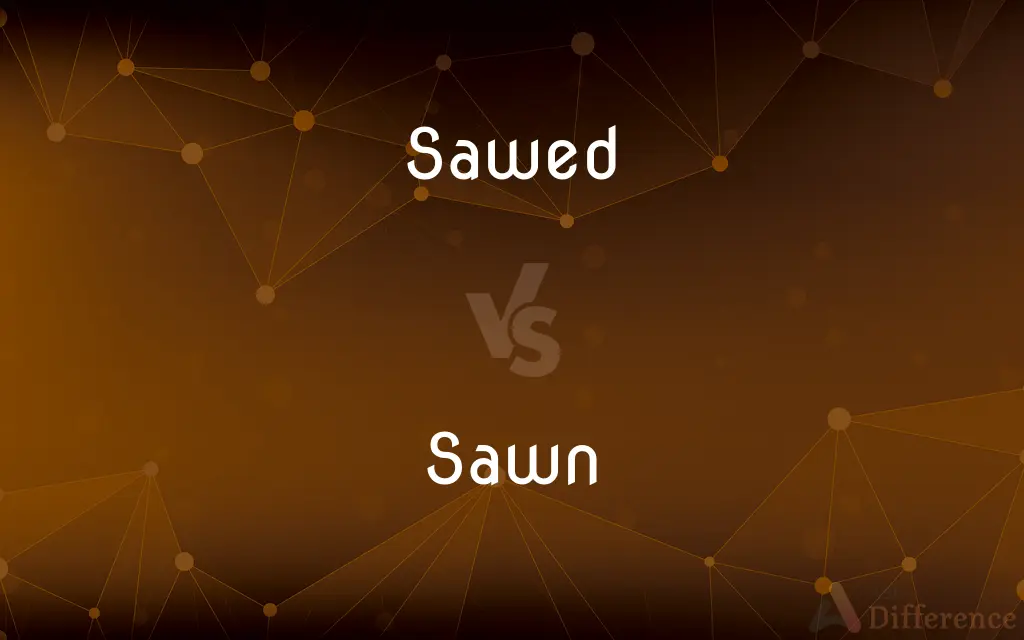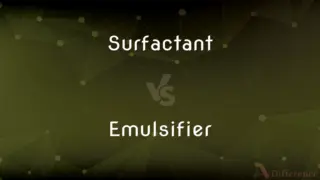Sawed vs. Sawn — What's the Difference?
By Fiza Rafique & Urooj Arif — Updated on March 18, 2024
Sawed is the past tense of saw, implying an action completed using a saw tool, whereas sawn is the past participle, used with have, has, or had.

Difference Between Sawed and Sawn
Table of Contents
ADVERTISEMENT
Key Differences
Sawed refers to the action of cutting with a saw, emphasizing the action itself during a specific time. Sawn, on the other hand, is the past participle form of saw, often used to describe the state of an object after the action has been completed, especially in passive constructions or perfect tenses.
While "sawed" highlights the act of cutting, focusing on the process, "sawn" emphasizes the result or outcome of this action. This distinction is useful in conveying the nuance between the ongoing action of cutting (sawed) and the completion of the action (sawn).
The usage of "sawed" and "sawn" can also reflect regional preferences or stylistic choices in English. In some dialects, "sawed" might be used more frequently for both the past tense and past participle, whereas "sawn" might be more common in others, especially in formal or written English.
Comparison Chart
Form
Past tense
Past participle
Usage
Describes the action of cutting
Describes the state after cutting
ADVERTISEMENT
Example
He sawed the wood yesterday.
The wood has been sawn into pieces.
Emphasis
On the process of cutting
On the result of the cutting
Common in
Specific time or context
Passive constructions or perfect tenses
Compare with Definitions
Sawed
Used metaphorically to describe intense effort.
He sawed through the competition.
Sawn
Having been cut with a saw.
The sawn timber was ready for construction.
Sawed
To divide by cutting with a saw.
They sawed the large cake into small pieces for the guests.
Sawn
Used to describe the texture or condition of a surface after cutting.
Sawn edges are often rough.
Sawed
Cut with a saw.
He sawed the log into two pieces.
Sawn
Referring to objects or materials cut into specific shapes or sizes.
The sawn planks were stacked neatly.
Sawed
To make a motion or produce an effect similar to cutting with a saw.
She sawed her hands through the air to demonstrate the action.
Sawn
To describe the outcome of sawing.
The sawn pieces were examined for quality.
Sawed
To operate a saw.
He sawed diligently, focusing on his work.
Sawn
In passive constructions, emphasizing the completed action.
The branches were sawn off the tree.
Sawed
Any of various tools, either hand-operated or power-driven, having a thin metal blade or disk with a sharp, usually toothed edge, used for cutting wood, metal, or other hard materials.
Sawn
A past participle of saw1.
Sawed
To cut or divide with a saw.
Sawn
Past participle of saw
Sawed
To produce or shape with a saw
Sawed a hole in the board.
Sawn
Past participle of see; seen
Sawed
To make back-and-forth motions through or on
A speaker who saws the air with his arms.
Sawed
To use a saw
Sawing along the chalk line.
Sawed
To undergo cutting with a saw
Pine wood saws easily.
Sawed
Past tense of see1.
Sawed
Simple past tense and past participle of saw
Common Curiosities
Is sawn only used in passive sentences?
Sawn is commonly used in passive constructions and perfect tenses, but it's not exclusive to them.
What is the difference between sawed and sawn?
Sawed is the past tense of saw, indicating the action of cutting, while sawn is the past participle, used to describe the state after cutting.
Why would someone choose sawed over sawn in a sentence?
The choice depends on the intended emphasis: sawed emphasizes the action, while sawn focuses on the result.
Can "sawed" ever be used in a passive construction?
While less common, "sawed" can appear in passive constructions, particularly in informal contexts or regional dialects.
Is it correct to say "the board was sawed in half"?
While "the board was sawn in half" is more standard, "the board was sawed in half" can be acceptable in certain dialects or styles.
Are there any exceptions to using sawed and sawn according to their grammatical roles?
Exceptions mainly arise from regional variations or stylistic choices, affecting the preference for one over the other.
Are sawed and sawn acceptable in both American and British English?
Yes, both terms are acceptable in American and British English, though their usage may vary by region.
Can sawed and sawn be used interchangeably?
They cannot be used interchangeably since they serve different grammatical purposes; sawed is used for the past tense, and sawn for the past participle.
How does the use of sawed vs. sawn affect the tone of a text?
Using "sawn" can lend a more formal or technical tone, whereas "sawed" might be seen as more casual or immediate.
How do I know when to use sawed vs. sawn in writing?
Consider whether you're emphasizing the action of cutting (sawed) or the result (sawn), and the grammatical construction of your sentence.
What is the correct past participle of saw, sawed, or sawn?
The correct past participle is "sawn," but "sawed" is also used in some contexts, especially in American English.
Is "sawn" a newer form than "sawed"?
"Sawn" is not necessarily newer; both forms have existed for a long time, with usage depending on dialect and context.
What tense should I use with "sawn" in a sentence?
"Sawn" is typically used with perfect tenses or passive voice, requiring auxiliary verbs like "has," "have," or "had."
Can "sawed" be used to describe a finished product?
Typically, "sawn" is used to describe a finished product, but "sawed" might be used informally or in specific contexts.
Does the preference for "sawed" or "sawn" change in different types of English?
Yes, there might be a slight preference for one over the other in different English dialects, with "sawn" often favored in British English.
Share Your Discovery

Previous Comparison
Lane vs. Path
Next Comparison
Surfactant vs. EmulsifierAuthor Spotlight
Written by
Fiza RafiqueFiza Rafique is a skilled content writer at AskDifference.com, where she meticulously refines and enhances written pieces. Drawing from her vast editorial expertise, Fiza ensures clarity, accuracy, and precision in every article. Passionate about language, she continually seeks to elevate the quality of content for readers worldwide.
Co-written by
Urooj ArifUrooj is a skilled content writer at Ask Difference, known for her exceptional ability to simplify complex topics into engaging and informative content. With a passion for research and a flair for clear, concise writing, she consistently delivers articles that resonate with our diverse audience.















































